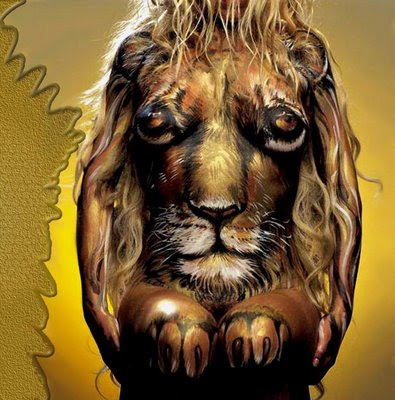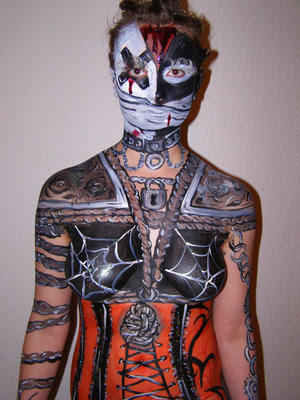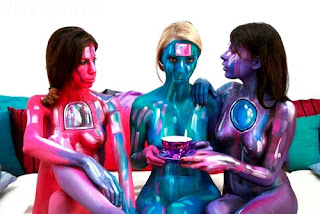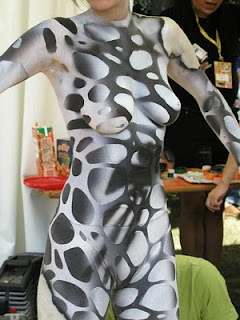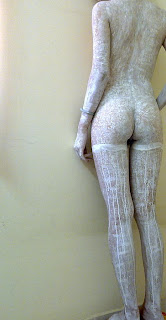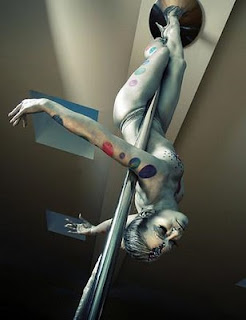Paint-Zone - High Quality Auto Paint and Retouching including Complete Auto Body and Collision Repair
Monday, December 12, 2011
Thursday, November 10, 2011
Western Painting - Body Painting
The origin of body painting is unknown, but its use has been widespread - sometimes as an art form, sometimes as a part of tradition, and the other times, as a necessity. The evidence of body painting is found in ancient practices across various cultures and remains a popular fashion statement in the present times. There is no set style or technique for body painting. It can be a localized design or a fuller one, covering the entire body in some cases. The color pigments used can be natural or synthetic. Similarly, it can be a work of an expert or an amateurish hand of a novice. However, unlike permanent tattoos, body paints are temporary or semi-permanent in nature.
 Painting the body was prevalent in ancient Egyptian civilization, where Pharaohs and high-class individuals painted their faces in red ochre & white pigments, and eyes in kohl. The Himba group of Namibia also generously uses red ochre. These people paint their entire bodies in the uniform pigment, as a traditional practice. In India, body painting is an elaborate work of expertise, which requires training and a lot of experience. One of the best examples of this art is the make-up of Kathakali dancers that involves the use of white, red, black, and yellow colors against a base of bottle green color, on face.
Painting the body was prevalent in ancient Egyptian civilization, where Pharaohs and high-class individuals painted their faces in red ochre & white pigments, and eyes in kohl. The Himba group of Namibia also generously uses red ochre. These people paint their entire bodies in the uniform pigment, as a traditional practice. In India, body painting is an elaborate work of expertise, which requires training and a lot of experience. One of the best examples of this art is the make-up of Kathakali dancers that involves the use of white, red, black, and yellow colors against a base of bottle green color, on face. The use of 'henna,' a natural plant extract, is very popular among the Indian women across the country and is again, done by trained experts. Henna is used for decorating the hands and feet in beautiful, complex designs. Native Americans use streaks, concentric circles, and other patterns of colors, which include red, white, yellow, blue, and black. The indigenous Yolngu people of Australia use detailed and painstaking technique to embellish their bodies. It is an inspiration for many other art forms and a job that only the experts can do.
The use of 'henna,' a natural plant extract, is very popular among the Indian women across the country and is again, done by trained experts. Henna is used for decorating the hands and feet in beautiful, complex designs. Native Americans use streaks, concentric circles, and other patterns of colors, which include red, white, yellow, blue, and black. The indigenous Yolngu people of Australia use detailed and painstaking technique to embellish their bodies. It is an inspiration for many other art forms and a job that only the experts can do. Painted faces have been a trademark of comedians and mimics, throughout the history of performing arts. Body painting has found as much use in military operations, as in local communities. Facial colors, particularly in nature tones are heavily employed as camouflage by almost all armies in the world. Now days, this art has become a fad, especially among the youth and is treated more as an avant-garde fashion accessory, rather than as a religious belief. Across the US and Europe, body painting is used in theatre, cinema, fashion, carnivals, and body painting festivals. Despite facing criticism and rejection from various corners, this art continued to grow and is still evolving!
Painted faces have been a trademark of comedians and mimics, throughout the history of performing arts. Body painting has found as much use in military operations, as in local communities. Facial colors, particularly in nature tones are heavily employed as camouflage by almost all armies in the world. Now days, this art has become a fad, especially among the youth and is treated more as an avant-garde fashion accessory, rather than as a religious belief. Across the US and Europe, body painting is used in theatre, cinema, fashion, carnivals, and body painting festivals. Despite facing criticism and rejection from various corners, this art continued to grow and is still evolving!

Saturday, October 22, 2011
All About Body Painting Of Women
There is nothing quite like the allure of body art on women. I’m not talking so much about permanent body art like tattoos (which also can be nice), but instead the use of body paint. It’s so versatile. You can use it to dress up like your favorite character, pretend like you’re wearing a swimsuit, support the local sports team, advertise, or simply go artistic. There are even competitions around the globe where people compete for prizes.
Monday, October 3, 2011
Thursday, September 29, 2011
Monday, September 19, 2011
Tuesday, September 13, 2011
Monday, August 8, 2011
Wednesday, August 3, 2011
Saturday, July 30, 2011
Thursday, July 28, 2011
Amber Chia In Tiger Stripes Body Paint
Malaysian Supermodel Amber Chia earned her stripes for wildlife conservation Saturday by sitting still as her famous body was painted to look like a tiger.
 She told reporters after the photo shoot at Mutiara Damansara that it took three hours but she did not mind as it was for a good cause.
She told reporters after the photo shoot at Mutiara Damansara that it took three hours but she did not mind as it was for a good cause.
The shoot was for PETA (People for the Ethical Treatment of Animals) Asia Pacific.
 Amber is the latest in the line of celebrities featured in a new anti-captivity advertisement for PETA.
Amber is the latest in the line of celebrities featured in a new anti-captivity advertisement for PETA.Besides a jungle setting as the backdrop, she will also be photographed in a steel cage measuring 70cm x 70cm x 90cm.
The photographs will appear on posters and newspapers across the globe early next year in a campaign against zoos.
Next year, being the Year of the Tiger was among the reasons Amber was chosen to be a part of the campaign.
"She was chosen because she has a compassion for animals," senior PETA campaigner Ashley Fruno said.
Amber is the first Malaysian celebrity PETA had roped in to help their cause to urge people to boycott zoos.
"Wild animals belong in the wild. An animal that lives a long and healthy life but dies in the wild is not worse off than animals which spend all their lives pacing in enclosures," Fruno said.
Labels:
Tiger
Monday, July 25, 2011
Thursday, July 14, 2011
Subscribe to:
Comments (Atom)


